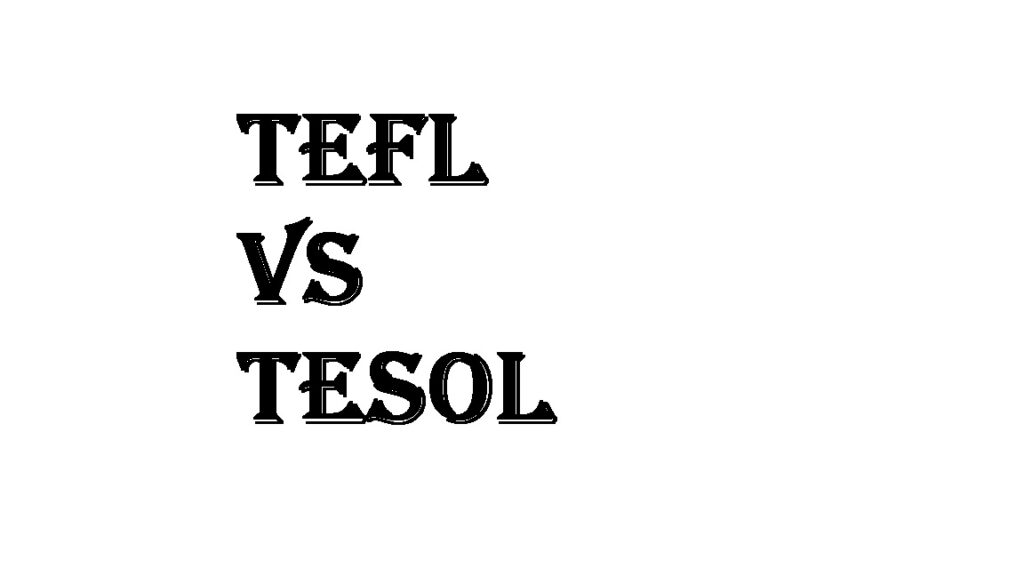Difference between TEFL and TESOL
TEFL (Teaching English as a Foreign Language) and TESOL (Teaching English to Speakers of Other Languages) are both acronyms used to refer to teaching English to non-native speakers. While they are often used interchangeably, there are some subtle differences between the two terms.
Scope of Application:
TEFL typically refers to teaching English in countries where English is not the primary language. It focuses on teaching English to students who may not use English in their daily lives and primarily need it for academic or professional purposes.
TESOL is a broader term that encompasses both TEFL and teaching English in contexts where English is used as a second language. It includes teaching English to immigrants or English-speaking communities where English is not the dominant language.
Geographic Focus:
TEFL generally emphasizes teaching English in non-English-speaking countries, such as teaching English in China, Japan, or Brazil.
TESOL covers a wider range of locations, including English-speaking countries with diverse populations of non-native English speakers, like the United States, Canada, the United Kingdom, or Australia.
Target Learners:
TEFL often focuses on teaching English to students who are learning English as an additional subject in their school curriculum or adults seeking to improve their English for specific purposes like business or travel.
TESOL encompasses teaching English to a broader range of learners, including immigrants, refugees, or individuals living in English-speaking countries who need English for everyday communication, education, or employment.
Professional Certifications:
TEFL certifications typically refer to programs that prepare individuals to teach English in foreign countries. These certifications may have different levels, such as a basic TEFL certificate or an advanced diploma.
TESOL certifications are designed to prepare individuals to teach English to speakers of other languages in various contexts. TESOL programs often cover both teaching English abroad and teaching English to immigrant or non-native English-speaking populations within English-speaking countries.
It’s important to note that the exact usage and interpretation of these terms can vary, and in practice, they are often used interchangeably. Ultimately, the choice between TEFL and TESOL depends on the specific context and target learners you are interested in teaching.
TEFL (Teaching English as a Foreign Language):
TEFL focuses on teaching English in countries where English is not the primary language.
The primary goal of TEFL is to help students develop their English language skills for academic or professional purposes.
TEFL teachers often work in language schools, universities, private institutions, or as private tutors in non-English-speaking countries.
TEFL programs and certifications typically cover topics such as English language teaching methodologies, lesson planning, classroom management, and assessment techniques.
TEFL teachers need to adapt their teaching methods to the cultural and linguistic backgrounds of their students, as well as the specific educational system of the country they are teaching in.
TEFL certifications can vary in duration and level of accreditation. Some programs offer short-term certificates, while others provide more extensive training and recognized credentials.
TESOL (Teaching English to Speakers of Other Languages):
TESOL is a broader term that encompasses teaching English to non-native speakers in a variety of contexts.
TESOL includes teaching English as a second language (ESL) in English-speaking countries, as well as teaching English as a foreign language (EFL) in non-English-speaking countries.
TESOL teachers may work with diverse populations, such as immigrants, refugees, international students, or individuals seeking to improve their English skills for personal or professional reasons.
TESOL programs cover a wide range of topics, including language acquisition theory, linguistics, cultural competence, instructional strategies for diverse learners, and curriculum development.
TESOL teachers need to be flexible and adaptable in their teaching approaches to meet the specific needs and goals of their students, who may come from various linguistic and cultural backgrounds.
TESOL certifications can vary in terms of duration, level of accreditation, and specialization. Some programs offer specialized certificates, such as Teaching English for Specific Purposes (TESP) or Teaching English to Young Learners (TEYL).
Both TEFL and TESOL provide valuable training and qualifications for individuals interested in teaching English to non-native speakers. The choice between TEFL and TESOL depends on factors such as the specific teaching context, the target learners, and the individual’s career goals. It’s worth researching and considering different program options to determine which one aligns best with your interests and aspirations in English language teaching.
How do the curriculum and teaching methods differ between TEFL and TESOL programs?
The curriculum and teaching methods in TEFL and TESOL programs can vary depending on the institution, program level, and specific focus. However, there are some general differences in curriculum and teaching approaches that can be observed between TEFL and TESOL programs:
TEFL Curriculum and Teaching Methods:
TEFL programs often focus on equipping teachers with the skills and knowledge to teach English as a foreign language in non-English-speaking countries.
The curriculum typically includes topics such as language teaching methodologies, lesson planning, classroom management, and assessment techniques.
TEFL programs may emphasize the teaching of academic English or English for specific purposes, such as business English or English for tourism.
Teaching methods in TEFL often prioritize communicative approaches, where there is an emphasis on speaking and listening skills, as well as interactive classroom activities.
TEFL programs may address cultural awareness and sensitivity, helping teachers understand the cultural contexts in which they will be teaching and adapt their instruction accordingly.
TEFL programs may include teaching practicum or observation components, providing hands-on experience in teaching English to non-native speakers.
TESOL Curriculum and Teaching Methods:
TESOL programs have a broader scope, encompassing both teaching English as a second language (ESL) and teaching English as a foreign language (EFL).
The curriculum in TESOL programs often includes a broader range of topics, such as language acquisition theory, linguistics, cultural competence, second language assessment, and curriculum development.
TESOL programs may address teaching English in various contexts, including academic settings, community programs, or workplace environments.
Teaching methods in TESOL can be diverse and adaptable, depending on the target learners and specific teaching context. They may include task-based learning, project-based learning, content-based instruction, or technology-enhanced approaches.
TESOL programs tend to emphasize the development of all language skills, including reading, writing, speaking, and listening, as well as grammar and vocabulary.
TESOL programs often address the needs of diverse learners, such as immigrants, refugees, or individuals with limited English proficiency, requiring teachers to employ differentiated instruction and cater to individual learner needs.
TESOL programs may offer specialized courses or modules, such as Teaching English for Specific Purposes (TESP), Teaching English to Young Learners (TEYL), or Teaching English for Academic Purposes (TEAP).
It’s important to note that these differences are not absolute, and there can be overlaps in the curriculum and teaching methods between TEFL and TESOL programs. The specific content and approach may vary depending on the program provider and the target audience the program aims to prepare teachers for. It’s advisable to research and review the curriculum and teaching methods of individual programs to determine which one aligns best with your teaching goals and the specific context you’re interested in.
TEFL Curriculum and Teaching Methods:
TEFL programs often provide a comprehensive understanding of language teaching methodologies, focusing on effective ways to teach English as a foreign language.
The curriculum may cover topics such as second language acquisition theories, lesson planning, classroom management, and assessment strategies.
TEFL programs typically emphasize practical teaching skills and techniques that can be applied in diverse classroom settings.
Teaching methods in TEFL often prioritize communicative language teaching (CLT), which encourages students to actively engage in meaningful communication in the target language.
TEFL programs may include modules on teaching specific skills like speaking, listening, reading, and writing, as well as grammar and vocabulary instruction.
Practical elements, such as teaching demonstrations, microteaching sessions, or teaching practicum, may be included in TEFL programs to provide hands-on teaching experience.
Some TEFL programs may offer specialization options, such as teaching young learners, business English, exam preparation, or English for specific purposes.
TESOL Curriculum and Teaching Methods:
TESOL programs encompass a broader range of teaching contexts, including both ESL (English as a Second Language) and EFL (English as a Foreign Language).
The curriculum in TESOL programs often includes foundational courses in areas such as linguistics, sociolinguistics, language acquisition theories, and cultural competence.
TESOL programs may explore diverse instructional approaches and methodologies, such as communicative language teaching (CLT), task-based learning, content-based instruction, or blended learning.
The curriculum may also cover areas like second language assessment, curriculum design and development, materials adaptation, and technology integration in language teaching.
TESOL programs often address the needs of specific learner populations, such as adult learners, young learners, or learners from multilingual backgrounds.
TESOL programs may include courses on teaching academic English, English for specific purposes (ESP), or English for specific professions.
Practical components like teaching observations, practice teaching, or internships in ESL/EFL classrooms may be included to provide hands-on experience.
It’s important to note that the curriculum and teaching methods can vary among different TEFL and TESOL programs. The specific content and approach will depend on the program’s focus, target learners, and the educational philosophy of the institution offering the program. When choosing a program, it’s recommended to carefully review the curriculum, course descriptions, and teaching methodologies to ensure they align with your teaching goals and the specific context you wish to work in.
Find us on Facebook

